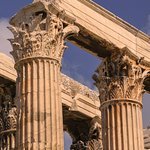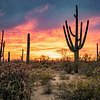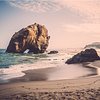Telluride & Ouray Trekking
With a number of scenic trails that begin right in town, and a vast majority of others located a bit further out that require a ride in one of our company rigs, the San Juan Mountains provide access to hanging valleys, endless ridge lines, and beautiful alpine lakes, making trekking in Telluride and Ouray a true world-class adventure.
The area has a rich mining history, so there are a number of ghost towns and mining remnants nestled into the surrounding mountains. A day spent trekking around Telluride will leave you in awe at what the early miners accomplished with minimal tools and resources in this rugged terrain.
Our day treks range from half day to full day and are crafted to give visitors a real Colorado experience with tremendous views, the opportunity to see wildlife, and our amazing high-alpine wildflowers. We offer many different treks and options for hikers of all abilities. Our guides are trained in local natural history and will offer interpretations as you trek through spectacular settings.
Our overnight treks last for up to three days/two nights as we hike across large swaths of uninhabited mountain terrain where few people venture. We have access to some remote corners of the San Juans that offer a variety of ecosystems. Our multi-day treks often travel on extensive, well-traveled trail systems in this area, but we also venture into lesser-traveled terrain to access seldom-visited areas.
If you have any questions about the area, a specific trek, or are unsure where to go, contact the Mountain Trip office at [email protected] or (970) 369-1153.
To make a reservation, please click below.
Half-Day Treks (4 Hours +/-)
- Treks from Telluride
- Silver Lake
- Wilson Meadows Overlook
- Waterfall and Swamp Canyons
- And many more!
Full-Day Treks (7-9 Hours +/-)
- Bilk Basin to Lizard Head Pass
- Waterfall Canyon to Swamp Canyon
- Lizard Head to Black Face
- Campbell Peak to Iron Mountain
- Ophir to Telluride
- Telluride “Seven Summits”
Trekking Peaks
- Yellow Mountain (13,177′)
- Sunshine Mountain (12,930′)
- Beattie Peak (13,342′)
- San Bernardo Peak
- Lone Cone
- Sheep Mountain
Overnight Treks
- Alpine Lake tour of Bridal Veil Basin
- Ophir to Telluride (Extended)
- Dolores Peak to Middle Peak Loop
- Trout Lake to Ophir
The following is a list of guide-recommended gear for Telluride day treks with Mountain Trip.
Many of the items on the list need to fit you well in order for you to fully enjoy your experience on the trail. Please plan ahead with clothing and footwear purchased for your trek so you can be certain that your gear fits you well. Descending down the Wasatch Trail is not the place to discover that your old rain coat is no longer waterproof or that your boots give you blisters.
In addition to what we provide and have available to rent, there is also a good selection of gear available in Telluride and Ouray. If you have any specific questions about what you might need, please don’t hesitate to reach out to the Mountain Trip office.
Footwear
| Gear | Description | Guide's Pick |
|---|---|---|
| Trekking Shoes or Boots for Colorado | Comfortable, well broken in trekking shoes or lightweight boots will work for approaching climbs, the Telluride Via Ferrata or climbing 14ers. Good traction is important for all of the above. Contact our office for more detailed advice! |
Torso Layers
| Gear | Description | Guide's Pick |
|---|---|---|
| “T” or Sun Shirt | Synthetic or synthetic/cotton blend shirts are nice for hiding from the sun. Long sleeve "sun hoodies" are becoming increasingly popular, as they provide a high level of sun protection. Other people favor ventilated, button up shirts- either long or short-sleeved. Whatever you choose, consider it as part of your system, and try it out before your trip. | |
| Rain Jacket for Colorado | A rain shell can be your most important layer as we often experience afternoon showers during the summer months in Colorado. It should be packable and in good working order meaning that, in addition to being waterproof, it still has a functional water repellent finish and beads water on the surface of the fabric. |
Leg Layers
| Gear | Description | Guide's Pick |
|---|---|---|
| Lightweight Softshell Trekking Pants | A lightweight synthetic softshell pant is a great layer that you'll wear every day on a trek or for an ascent of a peak. These are water resistant, breathable and comfortable in a wide range of weather and temps. |
Head and Hands
| Gear | Description | Guide's Pick |
|---|---|---|
| Sunglasses | Sunglasses are essential in the mountains. Choose a pair that are comfortable and provide 100% UVA and UVB protection. |
Packs and Duffels
| Gear | Description | Guide's Pick |
|---|---|---|
| Small Pack Colorado Day Hikes | Day hikes and the Via Ferrata require a small backpack or Camelback style hydration pack. It need only be large enough for a camera, water and light additional clothing layers for the day. |
Climbing Gear
| Gear | Description | Guide's Pick |
|---|---|---|
| Trekking Poles(Lightweight) | Trekking poles can be helpful for long days on the trail and help take some strain off of aching joints going downhill! These are typically lighter weight than a ski pole, and have a smaller basket as you don't use them in deep snow. |
Other
| Gear | Description | Guide's Pick |
|---|---|---|
| Two (2) One-Liter Water Bottles | You will need two, 1-liter plastic water bottles. Please bring wide-mouth bottles, such as those from Nalgene, as these are much easier to fill than bottles with small openings. | |
| Several Good Jokes! | "A Moose walks into a bar..." | |
| Lip Balm | Bring a tube of quality lip balm with sun protection (SPF). | |
| Sunscreen | The sun can be intense in Colorado, so please apply high SPF sunscreen prior to your trip and bring a small tube along to reapply during the day. |
The following is a list of guide-recommended gear for Telluride overnight treks with Mountain Trip.
Many of the items on the list need to fit you well in order for you to fully enjoy your experience on the trail. Please plan ahead with clothing, footwear, and gear purchased for your trek so you can be certain that your gear fits you well and works. Deep in the Lizard Head Wilderness is not the place to discover that your sleeping pad leaks air during the night.
In addition to what we provide and have available to rent, there is also a good selection of gear available in Telluride and Ouray. If you have any specific questions about what you might need, please don’t hesitate to reach out to the Mountain Trip office.
Footwear
| Gear | Description | Guide's Pick |
|---|---|---|
| Trekking Socks | Most trekkers prefer a light to medium weight, wool or wool/synthetic blend sock for use with trekking shoes. For longer treks bring a pair to change into every 2-3 days. | |
| Trekking Shoes or Boots for Colorado | Comfortable, well broken in trekking shoes or lightweight boots will work for approaching climbs, the Telluride Via Ferrata or climbing 14ers. Good traction is important for all of the above. Contact our office for more detailed advice! |
Torso Layers
| Gear | Description | Guide's Pick |
|---|---|---|
| Base Layer Top | (1 or 2 sets) of Wool or Capilene light weight base layers. Long sleeve or short sleeve base layers work well. | |
| Puffy Light Insulated Jacket | Size this layer to fit over your light fleece hoody and wind shell, and it is often layered underneath your expedition parka. Synthetic is easier to deal with and not worry about getting compared to a down filled layer. A hood on this layer in mandatory! *** Guides Tip! Use TWO lightweight puffy layers in the early season or if you are worried about being cold. A Micro or Nano Puff jacket with a Ultra Light Down Jacket or Vest allows versatile layering options. | |
| “T” or Sun Shirt | Synthetic or synthetic/cotton blend shirts are nice for hiding from the sun. Long sleeve "sun hoodies" are becoming increasingly popular, as they provide a high level of sun protection. Other people favor ventilated, button up shirts- either long or short-sleeved. Whatever you choose, consider it as part of your system, and try it out before your trip. | |
| Rain Jacket for Colorado | A rain shell can be your most important layer as we often experience afternoon showers during the summer months in Colorado. It should be packable and in good working order meaning that, in addition to being waterproof, it still has a functional water repellent finish and beads water on the surface of the fabric. |
Leg Layers
| Gear | Description | Guide's Pick |
|---|---|---|
| Hard Shell, Waterproof Pants | When it's raining a soft shell pant just isn't enough and you'll need a waterproof "hard shell" pant, meaning Gore-Tex or equivalent. These should be as light weight as possible. Fully separating side zippers will help you get them on without taking off your boots. On some peaks, you might carry hard shell pants for the lower mountain, but switch to soft shell pants for the colder and drier upper mountain. | |
| Underwear | Consider synthetic or Merino wool for your underwear. Most longer trips, such as Aconcagua or Denali, typically require 3-4 pair, but choose your quantity based on your personal level of comfort. | |
| Lightweight Softshell Trekking Pants | A lightweight synthetic softshell pant is a great layer that you'll wear every day on a trek or for an ascent of a peak. These are water resistant, breathable and comfortable in a wide range of weather and temps. |
Head and Hands
| Gear | Description | Guide's Pick |
|---|---|---|
| Light Weight Gloves | When the sun comes out on a glacier, the temperature can soar. Light weight, soft shell gloves are great for keeping the sun off your hands, while still giving you a bit of protection from the wind and cold. | |
| Buff Neck Gaiter | Buff is a brand of light weight neck gaiters that have grown to become a staple of every guide's kit. These are amazingly versatile, and can be worn as a hat, a neck gaiter or pulled over your face for protection from the wind or sun. They come in many thicknesses nowadays, but we prefer the original weight for its versatility. | |
| Warm Hat | Bring one warm hat or two hats of different weights. Wool or fleece are fine, but your hat must provide ear protection from the cold. | |
| Sun Hat | Baseball type or wide brimmed sun hats are required for protection against the intense sunshine found on many peaks. You can combine a baseball hat with a BUFF for good sun protection or go for a wide brimmed version to protect your face, ears and neck. | |
| Sunglasses | Sunglasses are essential in the mountains. Choose a pair that are comfortable and provide 100% UVA and UVB protection. |
Sleeping Gear
| Gear | Description | Guide's Pick |
|---|---|---|
| Inflatable Sleeping Pad | Inflatable pads have improved tremendously in recent years, they are the foundation of a warm and comfortable night! | |
| 0 degree Sleeping Bag | You'll want a bag rated to about 5 degrees Fahrenheit and warmer if you tend to sleep cold. Down or synthetic will work fine, although down is lighter and more compact for traveling and packing. |
Packs and Duffels
| Gear | Description | Guide's Pick |
|---|---|---|
| Trekking Backpack | Your pack size will ultimately be dependent on the length of your intended trip, but in general, a 45-60 liter backpack will fork well for overnight and multi-day treks. Light is right! Look for a pack weighing around five pounds or LESS. |
Climbing Gear
| Gear | Description | Guide's Pick |
|---|---|---|
| Trekking Poles(Lightweight) | Trekking poles can be helpful for long days on the trail and help take some strain off of aching joints going downhill! These are typically lighter weight than a ski pole, and have a smaller basket as you don't use them in deep snow. |
Other
| Gear | Description | Guide's Pick |
|---|---|---|
| Stuff Sacks | We are fans of the very light stiff sacks made from Sil Nylon fabric. Bring enough for your clothes and personal items. Light, zippered stuff bags are really nice for toiletries. | |
| Two (2) One-Liter Water Bottles | You will need two, 1-liter plastic water bottles. Please bring wide-mouth bottles, such as those from Nalgene, as these are much easier to fill than bottles with small openings. | |
| Large Plastic Bowl | Bowls are much easier to use and are much more versatile than are plates. Bring a 2-4 cup camping bowl or a plastic "Rubbermaid" style container for your mountain dining. | |
| Insulated Cup or Mug | A 12 - 16 ounce (350-500 Ml) mug with an attached lid will help keep you hydrated. The Kleen Kanteen Insulated Bottle with the "Cafe Cap" is pretty nifty, as it is a mug and a thermos all in one! | |
| Lexan Spoon | A soup spoon made from Lexan will survive most trips and is more useful and versatile than a fork or even a "spork." Mark your spoon with your initials to keep spoon rustlers at bay. | |
| Toiletry Kit | Tooth brush & paste, dental floss, Handi-wipes (1 per day on average), a small bottle of hand sanitizer, perhaps some foot powder… keep it small!!! | |
| Camera | Most climbers these days use their phone as a camera, but if you plan to bring a dedicated camera, consider a small, light weight point and shoot camera. If you are a photography buff and really want to bring a DSLR, plan for that extra weight with your training! | |
| Several Good Jokes! | "A Moose walks into a bar..." | |
| Lip Balm | Bring a tube of quality lip balm with sun protection (SPF). | |
| Sunscreen | The sun can be intense in Colorado, so please apply high SPF sunscreen prior to your trip and bring a small tube along to reapply during the day. | |
| Headlamp | Bring an extra set of batteries, as well. Lithium batteries work the best in cold weather!! For some trips (Carstensz, Everest, Cho Oyu) where we will be frequently climbing at night a second headlamp is a good idea, and always bring extra batteries! |
Inclusions and Exclusions
Included in the Trip Fee:
- Guidance of our highly experienced Mountain Trip guides.
- All necessary protective equipment where it is required.
- Assistance arranging post-trip activities in the area.
Not Included in the Trip Fee:
- Travel to and from southwest Colorado.
- Personal clothing and equipment per our equipment list. (Please, just ask us if you need anything!)
- Accommodations in Colorado.
- Travel and/or rescue insurance. (The CORSAR card is an inexpensive way to reimburse local rescue groups for costs incurred during a rescue in Colorado.)
- Costs incurred due to evacuation or unplanned departure from the area due to illness or other problems.
- Costs incurred as a result of delays beyond the control of Mountain Trip.
- Costs as a result of force majeure.
Refunds and Cancellations
Mountain Trip recognizes how difficult and disappointing it can be for guests who must cancel trips. Guests must also recognize that, due to the nature of planning trips and contracting guides for specific dates, Mountain Trip also accrues significant expenses in organizing our excursions. We must therefore adhere to a strict refund policy for all guests.
We require 100% payment at the time of booking and at least 72 hours’ notice for cancellations and rescheduling of activities. If you would like to purchase travel insurance to protect a trip in case of last-minute cancellations, you can do so via Travel Guard HERE.
We are happy to work with you to reschedule to a new date, or if you need to cancel entirely, we will provide a full refund with a minimum of 72 hours’ notice. If you cancel inside of 72 hours ahead of a trip departure, or do not show up, you will not be refunded and will have to reschedule by paying full price.
All requests for refunds must be made in writing and received in our Colorado office. No refunds will be provided for cancellations occurring within the last three days prior to the scheduled date of a trip.
Mountain Trip reserves the right to cancel a trip prior to the departure date for any reason. In such an event, all monies collected by Mountain Trip from trip participants shall be promptly refunded. This is the extent of our financial liability.
Weather Cancellations
We, Mountain Trip and our guides, reserve the right to make all weather-related decisions in regards to the cancellation of trips.




























